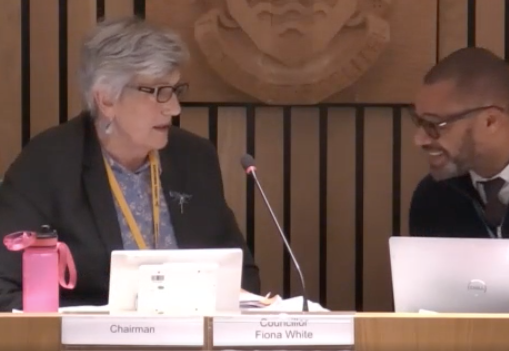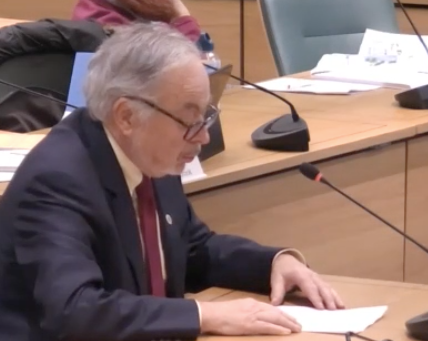 Abraham Lincoln
If given the truth, the people can be depended upon to meet any national crisis...
Abraham Lincoln
If given the truth, the people can be depended upon to meet any national crisis...
 Guildford news...
for Guildford people, brought to you by Guildford reporters - Guildford's own news service
Guildford news...
for Guildford people, brought to you by Guildford reporters - Guildford's own news service
Comment: Debenhams Plan – the Whole Character of Our Town is at Stake
Published on: 26 Nov, 2022
Updated on: 29 Nov, 2022

The buildings that will replace Guildford Debenhams according to CGI illustrations in the developer’s proposal. Image Squire and Partners
By Martin Giles
What next for the closed-up Debenhams store has been a major question facing the council since it shut up shop in January 2021.
The council does not own the site but clearly no one wanted an increasingly derelict building to decay slowly for decades as we have seen happen elsewhere in the town. After all, this is a landmark and gateway site at the bottom of the High Street.
Some do have affection for the large edifice dating back to the 1960s, but they are probably in the minority. The monolithic building hides the river and suffers from the adjacent busy road running along its entire frontage. Almost anything would be an improvement, some of us thought.
 But there were constraints. The busy road was not going to disappear and the developers would want a return on their investment. Demand, generally, for retail space has diminished while demand for housing is increasing but conversion to residential use would have been difficult.
But there were constraints. The busy road was not going to disappear and the developers would want a return on their investment. Demand, generally, for retail space has diminished while demand for housing is increasing but conversion to residential use would have been difficult.
Then there is the viability argument, which goes that the redevelopment must take into account the site value and give investors a suitable return, including a profit.
With no height limit policy in Guildford site values are effectively kept higher: more height equals more floor space to sell or let.
The problem is that public opinion is split on building height. No one has properly quantified the opinion of Guildford residents. It seems unlikely that there is an overwhelming majority for or against but the issue is fundamental to the future development of the town.
It is not just the look of individual buildings that is at stake but the whole character of our county town. Some might say “good”, some might shrug and say, “that’s progress” and some might despair.
Many are horrified by the high-rise developments in Woking. Although not of the same scale, here in Guildford the Solum railway station redevelopment, the “Plaza” site construction at the bottom of Portsmouth Road, and North Street regeneration all include high buildings, much higher than we’ve been used to, and they will doubtless be used to justify further high-rise applications.
This was the background to Tuesday’s Planning Committee meeting with a single item on the agenda: the application for 185 homes on the site.
The public speakers included a spokesman for the Guildford Residents Association and the chair of the Guildford Society: two leading groups, one representing thousands of residents, the other a body which has had a role in safeguarding Guildford’s heritage and architecture over decades.
Soon exposed, once the debate among committee members started, was a divide between the two largest parties at GBC who, in partnership, form the current administration.
It was clear from the contributions that R4GV members supported the proposal and the Lib Dems did not.

Planning Chair Fiona White (Lib Dem) telling a council officer: “That is a bloody horrible building,” immediately after she had closed the meeting.
With the meeting formally closed, the committee chairman, Cllr Fiona White, can be heard saying on the webcast: “That is a bloody awful building.” She has declined to say more. Her opinion probably resonated with many but appearance is not, perhaps surprisingly to those unfamiliar with the planning process, a valid reason to refuse permission.
The vote, largely along party political lines, will increase the pre-existing tension between the parties, particularly between the two largest groups at GBC, the Lib Dems and R4GV. It has been an open secret that the two groups do not see eye-to-eye but that is the nature of such political agreements and if there was no difference between them why have distinct parties?
 John Rigg (Holy Trinity) is the R4GV driving force behind the town centre planning intiatives and displays frustration with delay and obstruction. Certainly, the post-war history of slow-paced, ugly developments in Guildford might justify exasperation.
John Rigg (Holy Trinity) is the R4GV driving force behind the town centre planning intiatives and displays frustration with delay and obstruction. Certainly, the post-war history of slow-paced, ugly developments in Guildford might justify exasperation.
But if fast-paced, high-rise developments, still deemed inappropriate by the majority, simply replace those constructed at slower pace what will be gained?
It would not be surprising if he is irritated by the lack of support from the Lib Dem “partners”.
And the Lib Dem position on planning is still unclear. They are for more social housing. Who isn’t? But they have been unable to deliver anything significant, despite their ridiculous promise to build 3,000 during the 2019 election campaign.
And they are not a party that those worried about building height can rally around. They agree with R4GV, and the strong opinion of GBC planning officers, that a building height limit would be wrong for the town.
But they will naturally resent it if they feel strong-armed to support Cllr Rigg’s plans.
And what is the Conservative game plan? They were conspicuous by their silence. Bizarrely, for what was probably the most important planning decision since the Local Plan was adopted in 2019, two of the Conservative Planning Committee members, Cllrs David Bilbe and Marsha Moseley, did not even turn up and sent no substitutes. Even if he did not contribute to the debate and eventually abstained, at least their group leader, Cllr Paul Spooner, turned up.
Their failure to speak looked weak.
The position of Ramsey Nagety, leader of GGG, was also puzzling. Having pointed out some real concerns about the organisation of the demolition and removal of debris, he surprised some with his vote in favour. It turned out to be crucial, as did each vote when the motion was passed by a majority of one.
Next day, R4GV, the Lib Dems and the town centre Tories all made noises about producing statements but none has emerged. Perhaps now tempers have cooled they are all less certain about raising the political temperature but we do deserve to have clear communication on their various planning policies. It remains the most important item on the council’s agenda and we should all know what the parties stand for before we cast our votes next May.
Responses to Comment: Debenhams Plan – the Whole Character of Our Town is at Stake
Leave a Comment Cancel reply
Please see our comments policy. All comments are moderated and may take time to appear. Full names, or at least initial and surname, must be given.
Click on cartoon for Dragon story: Public Asked for Views on SCC’s Proposal for Reduced Speed Limits



Recent Articles
- SCC Calls on the Government To Protect the Environment
- Two-Week Road Closure on Portsmouth Road for Gas Network Upgrade
- Charlotteville Cycling Club Organises Another Successful Race Event
- Waverley Council To Bring Green Space Maintenance In-house
- A New Dementia Centre for Guildford
- Lib Dems Easily Hold Three Council Seats in Surrey By-elections
- UK Students to Launch International Space Mission
- New Skate Park Proposed for Cranleigh
- Retrofit Planned for Guildford Office Building
- Museum Shines a Light on Victorian Send, Ripley and Pyrford



Recent Comments
- Richard Cooke on Letter: Snail-paced Progress for Full Weir Repair
- Bethan Moore on Guildford’s First “Bike Bus”
- Andy Friend-Smith on Guildford’s First “Bike Bus”
- Peter Mills on Guildford’s First “Bike Bus”
- Des Flanders on Making History As Pewley School’s Class of ’54 Hold Their Final Reunion
- Margaret Rotherham on Guildford Festival Burst with Colour, Culture and Community Spirit
Search in Site
Media Gallery
Dragon Interview: Local Artist Leaves Her Mark At One of England’s Most Historic Buildings
January 21, 2023 / No Comment / Read MoreDragon Interview: Lib Dem Planning Chair: ‘Current Policy Doesn’t Work for Local People’
January 19, 2023 / No Comment / Read MoreA3 Tunnel in Guildford ‘Necessary’ for New Homes, Says Guildford’s MP
January 10, 2023 / No Comment / Read More‘Madness’ for London Road Scheme to Go Ahead Against ‘Huge Opposition’, Says SCC Leader
January 6, 2023 / No Comment / Read MoreCouncillor’s Son Starts Campaign for More Consultation on North Street Plan
December 30, 2022 / No Comment / Read MoreCounty Council Climbs Down Over London Road Works – Further ‘Engagement’ Period Announced
December 14, 2022 / No Comment / Read MoreDragon Interview: GBC Reaction to the Government’s Expected Decision to Relax Housing Targets
December 7, 2022 / No Comment / Read MoreHow Can Our Town Centre Businesses Recover? Watch the Shop Front Debate
May 18, 2020 / No Comment / Read More










Barbara Ford
November 26, 2022 at 4:00 pm
A thoughtful article.
It is easy to become exasperated with the whole thing but speaking for myself I don’t like either of the current Debenhams building or its proposed replacement. Maybe the essence of it is a choice between lesser of two evils – low-rise town centre decay and decline, or high-rise town centre regeneration. Or: maybe housing in the town centre is better than housing in the green belt?
Jules Cranwell
November 27, 2022 at 5:37 pm
Unfortunately, this development will not help to defend the green belt, after the Tory betrayal gifting it to developers in our 14 villages, with their despised Local Plan.
Developers will always favour the cheapest and most profitable method of building homes, which is in the green fields of our county, wherever they are allowed to.